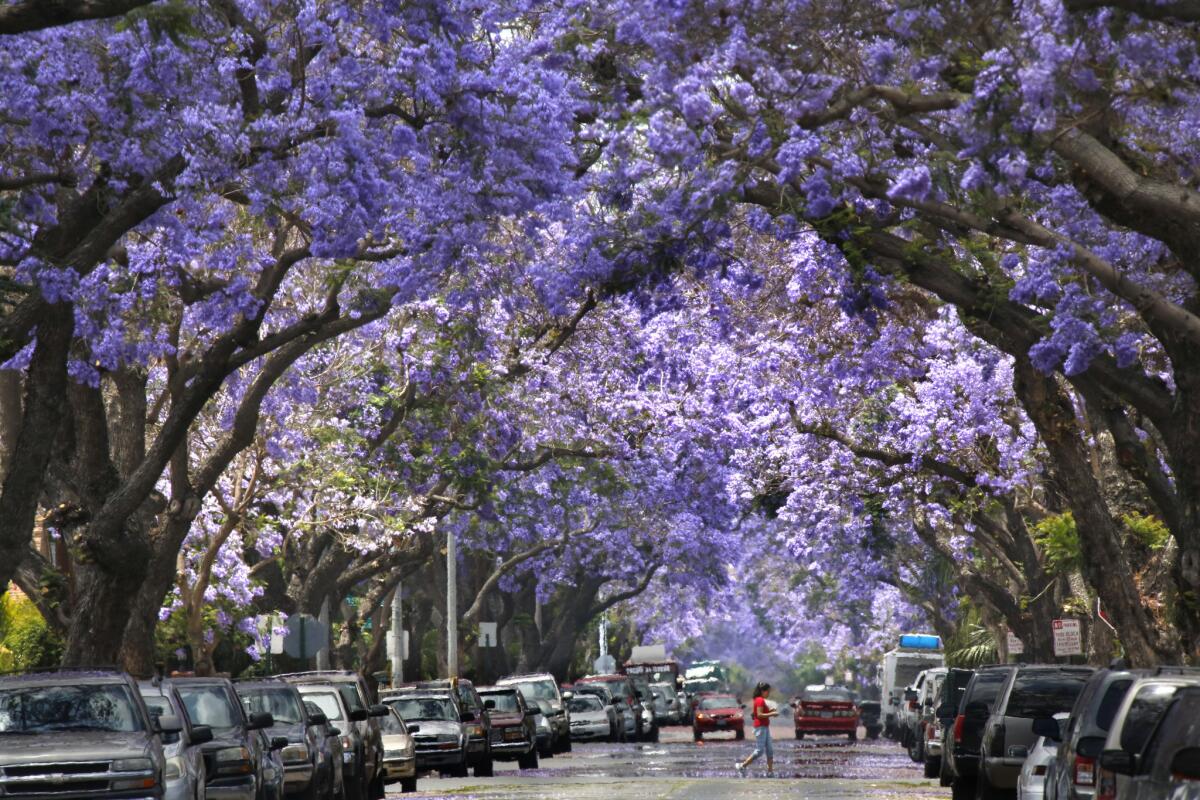Jacarandas: You either love them or hate them

The jacaranda is a striking but polarizing piece of the Southern California streetscape.
“They’re pretty, but sticky. If they get on your car it’s like getting married all over again when you drive off,” one Mar Vista resident told The Times in 2005, summarizing the love-hate relationship.
GRAPHIC: Your ultimate guide to the jacaranda
Here’s a brief history of the debate from The Times’ archives.
Lovers
Fullerton held its first Jacaranda Festival in 1931, drawing a big crowd. The theme was “the quest for the most beautiful blue in all the world.”
In 1933, the city forester declared the jacaranda the most exotic tree in Los Angeles.
“The jacaranda has two outstanding features: its unparalleled blue trumpet flowers in clusters ... and its finely cut fern-like dark green foliage,” L. Glenn Hall wrote in The Times.
Over the next few years, many cities planted the trees in parkways.
Glendale in 1972 declared the jacaranda its official tree. Developers used them to bring color to new housing tracts. In 1990, The Times wrote about using jacaranda wood to create perfectly smoked meat.
There was even a case of jacaranda envy years ago, when Costa Mesa residents learned that 11 trees removed from the city had been sold to Los Angeles and were planted as part of the refurbished Central Library in downtown Los Angeles.
Haters
Times columnist Jack Smith in 1982 wrote of his love for jacarandas — and got an earful from the trees’ detractors.
“I would hazard a guess that you don’t have a jacaranda tree,” one Downey resident, Linda Maxwell, wrote to Smith. “We used to have a jacaranda in our frontyard — we chopped it down.” Maxwell went on the describe the sticky liquid that accompanies the flowers. “Have you even walked barefoot down a street lined with jacarandas?”
Another resident told Smith: “After years of putting up with a year-round mess, I am about to put a chain saw to it. ‘Purple splendor.’ Bah.”
In 2000, residents in Yorba Linda pushed to have the city remove dozens of the trees, saying that the sticky flowers were littering their patios and choking spa filters.
“Jacarandas are beautiful,” one resident said. “But they don’t belong near homes. Their leaves and flowers make a mess on our yards and patios that’s impossible to clean.”
Those trees, however, received a reprieve.
One council member, explaining his vote to keep the jacarandas, said: “I’ve walked by jacaranda trees near my house and their beauty is really overpowering.”
So which camp do you fall in? Do you love them or hate them? And where is your favorite (or least favorite) place to see jacarandas? Post your photos on Instagram with the location and #FloweringLA.
Twitter: @shelbygrad
More to Read
Sign up for Essential California
The most important California stories and recommendations in your inbox every morning.
You may occasionally receive promotional content from the Los Angeles Times.











